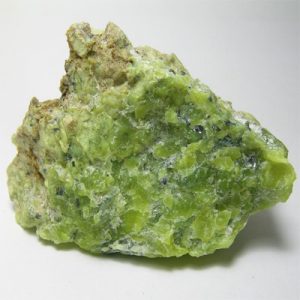Lizardite
Lizardite is a member of the Serpentine Group of minerals that also includes Antigorite and Chrysotile. These three minerals are polymorphous, meaning they have essentially the same chemistry but different structures. Antigorite is a fairly common member of the group, but Lizardite is the most abundant Serpentine. The Serpentine Group is a subgroup of the Kaolinite-Serpentine Group. At a Moh’s hardness of only 2.5 it is very soft, but its bright, apple green colors make for beautiful cabochons for collectors.
Lizardite distribution: Probably the most common serpentine mineral. A few prominent localities for well-studied material include: at Kennack Cove, The Lizard, Cornwall, England. On Unst, Shetland Islands, Scotland. From near Val Sissone, Lombardy, and Val Trebbia, Piacenza, Italy. In Japan, from Maruo Odori and Kodo, Yamaguchi Prefecture, and at Hamao, Fukuoka Prefecture. At Woodsreef, New South Wales, Australia. From the Jeffrey mine, Asbestos, Quebec, and the Cassiar mine, British Columbia, Canada. In the USA, at the Stillwater complex, Montana.
| Chemical Formula: | Mg3Si2O5(OH)4 |
| Magnesium Silicate Hydroxide | |
| Molecular Weight: | 277.11 gm |
| Composition: | Magnesium | 26.31 % | Mg | 43.63 % | MgO |
| Silicon | 20.27 % | Si | 43.36 % | SiO2 | |
| Hydrogen | 1.45 % | H | 13.00 % | H2O | |
| Oxygen | 51.96 % | O | |||
| 100.00 % | 100.00 % | = TOTAL OXIDE |
| Crystallography: | Triclinic – Pinacoidal |
| Crystal Habit: | Crystals rare, to 2 mm, as trigonal plates to truncated trigonal pyramids. Commonly as extremely fine-grained scales and massive aggregates. |
| Twinning: | Non |
| Cleavage: | Perfect on {0001} |
| Fracture: | n/a |
| Tenacity: | Crystals are easily bent |
| Moh’s Hardness: | 2.50 |
| Density: | 2.55 (g/cm3) |
| Luminescence: | None |
| Color: | Green, light yellow to white; colorless to pale green in thin section |
| Transparency: | Translucent |
| Luster: | Waxy |
| Refractive Index: | 1.538 – 1.568 Uniaxial ( – ) to slightly Biaxial ( – ) |
| Birefringence: | 0.012 |
| Dispersion: | Weak to distinct |
| Pleochroism: | n/a |


